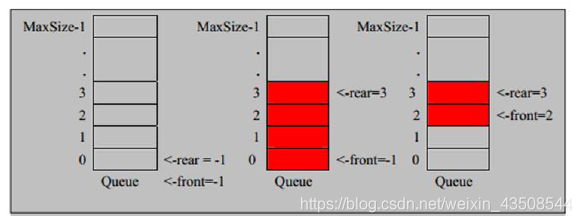一、现实场景
- 银行排队业务,先办完业务的先走,后来办业务的在后排队
- 食堂打饭,先打完饭的先走,后来食堂的在后排队
二、队列Queue
2.1 队列特点
- 队列是一个有序列表,可以用数组或者是链表来实现
- 遵循<font color="red">先进先出</font>的原则。即:先存入队列的数据,要先取出;后存入的数据,后取出

2.2 数组模拟队列思路
- 队列本身是有序列表,若使用数组的结构来存储队列的数据,则队列数组的声明如上图,其中
maxSize是该队列的最大容量。 因为队列的输出、输入是分别从前端和后端来处理,因此需要两个变量
front和rear分别记录队列前后端的下标,front会随着数据的输出而改变,而rear则随着数据的输入而改变。front初始化为-1,指向队列第一个元素的<font color="red">前一个位置</font>。rear初始化为-1,指向队列<font color="red">最后一个元素</font>的位置。(初始化不唯一,此处这样初始化)
front = rear时,队列为空。rear = maxSize - 1时,队列满,无法加入元素。将数据存入队列时方法为
addQueue,处理步骤如下:- 判断队列是否为满
- 若不满,将为指针往后移:
rear = rear + 1,将数据存入rear所指的下标中。
2.3 代码实现
import java.util.Scanner;
public class ArrayQueueDemo {
public static void main(String[] args) {
//测试一把
//创建一个队列
ArrayQueue queue = new ArrayQueue(3);
char key = ' '; //接收用户输入
Scanner scanner = new Scanner(System.in);//
boolean loop = true;
//输出一个菜单
while(loop) {
System.out.println("s(show): 显示队列");
System.out.println("e(exit): 退出程序");
System.out.println("a(add): 添加数据到队列");
System.out.println("g(get): 从队列取出数据");
System.out.println("h(head): 查看队列头的数据");
key = scanner.next().charAt(0);//接收一个字符
switch (key) {
case 's':
queue.showQueue();
break;
case 'a':
System.out.println("输出一个数");
int value = scanner.nextInt();
queue.addQueue(value);
break;
case 'g': //取出数据
try {
int res = queue.getQueue();
System.out.printf("取出的数据是%d\n", res);
} catch (Exception e) {
// TODO: handle exception
System.out.println(e.getMessage());
}
break;
case 'h': //查看队列头的数据
try {
int res = queue.headQueue();
System.out.printf("队列头的数据是%d\n", res);
} catch (Exception e) {
// TODO: handle exception
System.out.println(e.getMessage());
}
break;
case 'e': //退出
scanner.close();
loop = false;
break;
default:
break;
}
}
System.out.println("程序退出~~");
}
}
// 使用数组模拟队列-编写一个ArrayQueue类
class ArrayQueue {
private int maxSize; // 表示数组的最大容量
private int front; // 队列头
private int rear; // 队列尾
private int[] arr; // 该数据用于存放数据, 模拟队列
// 创建队列的构造器
public ArrayQueue(int arrMaxSize) {
maxSize = arrMaxSize;
arr = new int[maxSize];
front = -1; // 指向队列头部,分析出front是指向队列头的前一个位置.
rear = -1; // 指向队列尾,指向队列尾的数据(即就是队列最后一个数据)
}
// 判断队列是否满
public boolean isFull() {
return rear == maxSize - 1;
}
// 判断队列是否为空
public boolean isEmpty() {
return rear == front;
}
// 添加数据到队列
public void addQueue(int n) {
// 判断队列是否满
if (isFull()) {
System.out.println("队列满,不能加入数据~");
return;
}
rear++; // 让rear 后移
arr[rear] = n;
}
// 获取队列的数据, 出队列
public int getQueue() {
// 判断队列是否空
if (isEmpty()) {
// 通过抛出异常
throw new RuntimeException("队列空,不能取数据");
}
front++; // front后移
return arr[front];
}
// 显示所有数据
// 这里也有缺陷,只是单纯的输出了数组中的所有元素,而不是队列
public void showQueue() {
// 遍历
if (isEmpty()) {
System.out.println("队列空的,没有数据~~");
return;
}
for (int i = 0; i < arr.length; i++) {
System.out.printf("arr[%d]=%d\n", i, arr[i]);
}
}
// 显示队列的头数据, 注意不是取出数据
public int headQueue() {
// 判断
if (isEmpty()) {
throw new RuntimeException("队列空的,没有数据~~");
}
return arr[front + 1];//front + 1 不等于 front++ ,前者为运算,后者为复制
//front++ 等价于 front = front + 1
}
}
2.4 缺陷所在以及优化思路
- 目前数组使用一次就不能用,没有达到复用的效果

- 将这个数组使用算法,改进成<font color="red">环形的队列</font>。(取模 %)
三、数组模拟环形队列
- 对前面的数组模拟队列进行优化,充分利用数组,因此将数组看做是一个环形的
3.1 思路分析
front指向队列的<font color="red">第一个元素</font>的位置- 初始值为0
rear指向队列最后一个元素的<font color="red">后一个位置</font>- 初始值为0
- 将数组的最后一个位置作为<font color="red">指针传送门</font>的位置
尾索引
rear的下一个为头索引front时,表示队列满- 队列满的条件:
(rear + 1) % maxSize == front
- 队列满的条件:
头尾索引相同时,表示队列空
- 队列空的条件:
rear == front
- 队列空的条件:
- 队列中的有效的数据个数为
(rear + maxSize -front) % maxSize


3.2 代码实现
import java.util.Scanner;
public class CircleArrayQueueDemo {
public static void main(String[] args) {
//测试一把
System.out.println("测试数组模拟环形队列的案例~~~");
// 创建一个环形队列
CircleArray queue = new CircleArray(4); //说明设置4, 其队列的有效数据最大是3
char key = ' '; // 接收用户输入
Scanner scanner = new Scanner(System.in);//
boolean loop = true;
// 输出一个菜单
while (loop) {
System.out.println("s(show): 显示队列");
System.out.println("e(exit): 退出程序");
System.out.println("a(add): 添加数据到队列");
System.out.println("g(get): 从队列取出数据");
System.out.println("h(head): 查看队列头的数据");
key = scanner.next().charAt(0);// 接收一个字符
switch (key) {
case 's':
queue.showQueue();
break;
case 'a':
System.out.println("输出一个数");
int value = scanner.nextInt();
queue.addQueue(value);
break;
case 'g': // 取出数据
try {
int res = queue.getQueue();
System.out.printf("取出的数据是%d\n", res);
} catch (Exception e) {
// TODO: handle exception
System.out.println(e.getMessage());
}
break;
case 'h': // 查看队列头的数据
try {
int res = queue.headQueue();
System.out.printf("队列头的数据是%d\n", res);
} catch (Exception e) {
// TODO: handle exception
System.out.println(e.getMessage());
}
break;
case 'e': // 退出
scanner.close();
loop = false;
break;
default:
break;
}
}
System.out.println("程序退出~~");
}
}
class CircleArray {
private int maxSize; // 表示数组的最大容量
//front 变量的含义做一个调整: front 就指向队列的第一个元素, 也就是说 arr[front] 就是队列的第一个元素
//front 的初始值 = 0
private int front;
//rear 变量的含义做一个调整:rear 指向队列的最后一个元素的后一个位置. 因为希望空出一个空间做为指针传送门
//rear 的初始值 = 0
private int rear; // 队列尾
private int[] arr; // 该数据用于存放数据, 模拟队列
public CircleArray(int arrMaxSize) {
maxSize = arrMaxSize;
arr = new int[maxSize];
}
// 判断队列是否满
public boolean isFull() {
return (rear + 1) % maxSize == front;
}
// 判断队列是否为空
public boolean isEmpty() {
return rear == front;
}
// 添加数据到队列
public void addQueue(int n) {
// 判断队列是否满
if (isFull()) {
System.out.println("队列满,不能加入数据~");
return;
}
//直接将数据加入
arr[rear] = n;
//将 rear 后移, 这里必须考虑取模
rear = (rear + 1) % maxSize;
}
// 获取队列的数据, 出队列
public int getQueue() {
// 判断队列是否空
if (isEmpty()) {
// 通过抛出异常
throw new RuntimeException("队列空,不能取数据");
}
// 这里需要分析出 front是指向队列的第一个元素
// 1. 先把 front 对应的值保留到一个临时变量
// 2. 将 front 后移, 考虑取模
// 3. 将临时保存的变量返回
int value = arr[front];
front = (front + 1) % maxSize;
return value;
}
// 显示队列的所有数据
public void showQueue() {
// 遍历
if (isEmpty()) {
System.out.println("队列空的,没有数据~~");
return;
}
// 思路:从front开始遍历,遍历多少个元素
// 动脑筋
for (int i = front; i < front + size() ; i++) {
System.out.printf("arr[%d]=%d\n", i % maxSize, arr[i % maxSize]);
}
}
// 求出当前队列有效数据的个数
public int size() {
// rear = 2
// front = 1
// maxSize = 3
return (rear + maxSize - front) % maxSize;//+maxSize,保证rear在front前边时,计算的结果为正
}
// 显示队列的头数据, 注意不是取出数据
public int headQueue() {
// 判断
if (isEmpty()) {
throw new RuntimeException("队列空的,没有数据~~");
}
return arr[front];
}
}